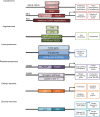A review of soft-tissue sarcomas: translation of biological advances into treatment measures
- PMID: 29785138
- PMCID: PMC5955018
- DOI: 10.2147/CMAR.S159641
A review of soft-tissue sarcomas: translation of biological advances into treatment measures
Abstract
Soft-tissue sarcomas are rare malignant tumors arising from connective tissues and have an overall incidence of about five per 100,000 per year. While this diverse family of malignancies comprises over 100 histological subtypes and many molecular aberrations are prevalent within specific sarcomas, very few are therapeutically targeted. Instead of utilizing molecular signatures, first-line sarcoma treatment options are still limited to traditional surgery and chemotherapy, and many of the latter remain largely ineffective and are plagued by disease resistance. Currently, the mechanism of sarcoma oncogenesis remains largely unknown, thus necessitating a better understanding of pathogenesis. Although substantial progress has not occurred with molecularly targeted therapies over the past 30 years, increased knowledge about sarcoma biology could lead to new and more effective treatment strategies to move the field forward. Here, we discuss biological advances in the core molecular determinants in some of the most common soft-tissue sarcomas - liposarcoma, angiosarcoma, leiomyosarcoma, rhabdomyosarcoma, Ewing's sarcoma, and synovial sarcoma - with an emphasis on emerging genomic and molecular pathway targets and immunotherapeutic treatment strategies to combat this confounding disease.
Keywords: genomics; immunotherapy; molecular pathways; sarcoma.
Conflict of interest statement
Disclosure The authors report no conflicts of interest in this work.
Figures

References
-
- Jemal A, Tiwari RC, Murray T, et al. Cancer statistics, 2004. CA Cancer J Clin. 2004;54:8–29. - PubMed
-
- Siegel RL, Miller KD, Jemal A. Cancer statistics. CA Cancer J Clin. 2015;65:5–29. - PubMed
-
- Christie-Large M, James SL, Tiessen L, Davies AM, Grimer RJ. Imaging strategy for detecting lung metastases at presentation in patients with soft tissue sarcomas. Eur J Cancer. 2008;44:1841–1845. - PubMed
-
- American Cancer Society Survival by stage of soft tissue sarcoma. 2017. [Accessed March 28, 2018]. Available from: https://www.cancer.org/cancer/soft-tissue-sarcoma/detection-diagnosis-st....
Publication types
LinkOut - more resources
Full Text Sources
Other Literature Sources
Miscellaneous

